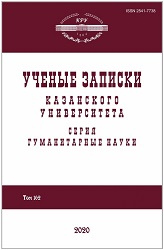Рецепция античности в шпалерах Фландрии XV –XVI вв. (на примере собрания Государственного Эрмитажа)
Reception of Antiquity through Flemish Tapestries of the 15th–16th Centuries (Based on the Collection of the State Hermitage Museum)
Author(s): Mariya Aleksandrovna ManokhinaSubject(s): Cultural history, Museology & Heritage Studies, 15th Century, 16th Century
Published by: Казанский (Приволжский) федеральный университет
Keywords: tapestry; reception; Flanders; Maximilian I; Charles V; House of Farnese; State Hermitage Museum; ancient literature; Renaissance;
Summary/Abstract: The problem of reception of the antiquity through tapestries in the Russian historiography was considered. Using as an example the Flemish tapestries of the 15th–16th centuries from the Collection of the State Hermitage Museum, the transformation and popularity of ancient motifs in this art form were demonstrated, as well as their special role in the propaganda of power, high social status, and wealth. The following main elements of tapestries were analyzed: subjects, characters, costumes, and Latin banderoles. The methodology of tapestry analysis is similar to the one used by structuralists: an additional link (customer) is introduced in the author – text – reader research field. The subjects of the tapestries were compared with the plots of the corresponding ancient literary sources. As a result, it was concluded about different perception of the antiquity in the literature and fine arts. Tapestries reflect the attitude of customers to the political reality of that time. The Northern Renaissance and how it was influenced by the ideas of humanists embodied in the tapestries was discussed.
Journal: Ученые записки Казанского университета. Серия Гуманитарные науки
- Issue Year: 162/2020
- Issue No: 6
- Page Range: 74-85
- Page Count: 12
- Language: Russian

